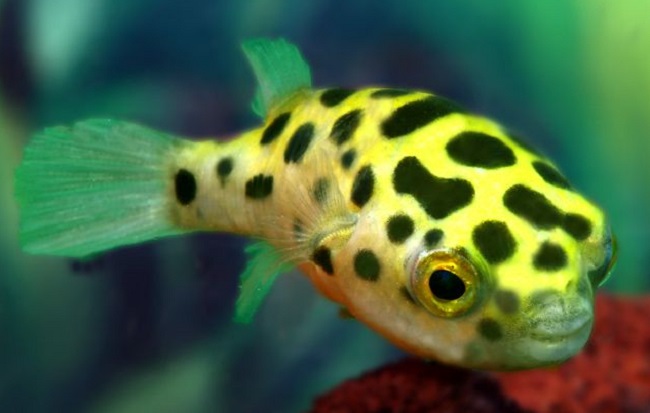Freshwater puffer fish, renowned for their distinctive appearance and lively personalities, have steadily gained popularity among aquarium enthusiasts. These unique creatures offer a touch of the exotic and require specialized care to thrive.
In this guide, we’ll explore 11 fascinating types of freshwater puffer fish, their traits, and what it takes to create a suitable environment for them in your home aquarium.

Types of Freshwater Pufferfish
Here are some of the types of the pufferfish:
Read Also:
1. Green Spotted Puffer Fish
Green Spotted Puffer Fish is adorned with vivid green spots on a dark background. They can be quite aggressive and are best kept in a species-only tank.
They need a diet rich in protein, such as shrimp and snails, and a tank size of at least 30 gallons as they can grow up to 6 inches.
2. Figure 8 Puffer Fish
Named for the “8” shaped markings on its back, the Figure 8 Puffer Fish is a brackish water species. This means that they require a mix of fresh and saltwater. They are relatively small and do well in tanks around 15-20 gallons. They enjoy a diet of crustaceans and mollusks.
3. Red Eye Puffer Fish
Red Eye Puffer Fish are very small, with an adult size of just 1.4 inches. They have distinctive black stripes and vibrant red eyes. These fish are carnivorous and prefer live food, such as small snails. They do well in small tanks but need clean water with regular changes.
4. Malabar Puffer Fish (Indian Dwarf Puffer)
Malabar Puffer Fish are tiny, peaceful fish native to the rivers of India. They thrive in heavily planted tanks that mimic their natural habitat. Their diet mainly consists of snails and other small invertebrates.
5. Fahaka Puffer Fish (Nile Puffer)
Fahaka Puffer Fish are large and require at least a 120-gallon tank. They can be aggressive and are best kept alone. Their diet should include hard-shelled food such as snails to help wear down their ever-growing teeth.
6. Amazon Puffer Fish
Amazon Puffer Fish are more social than most puffers and can be kept in groups or with other large, non-aggressive fish. They require a varied diet including crustaceans, mollusks, and plant matter. A tank of at least 30 gallons is recommended.
7. Congo Puffer Fish
Congo Puffer Fish are relatively rare and sought after due to their stunning coloration. They require a diet of snails, worms, and other invertebrates. They can be somewhat aggressive and should be kept in a species-only tank of at least 40 gallons.
8. Crested Puffer Fish
Crested Puffer Fish are known for the distinct ridge on their back. They are a peaceful species and can be kept in community tanks. They need a varied diet of plant matter and protein sources, and a tank size of at least 30 gallons.
9. Mbu Puffer Fish
Mbu Puffer Fish is one of the largest freshwater puffers. They require a very large tank, 500 gallons or more. They are carnivorous and need a diet rich in shellfish, crustaceans, and other hard foods to keep their beaks trimmed.
10. Golden Puffer Fish
Golden Puffer Fish have a bright, golden-yellow color and grow up to 7 inches. They need a tank of at least 50 gallons and a diet rich in crustaceans and other invertebrates. They can be aggressive, especially towards other puffers.
11. Leopard Puffer Fish
Leopard Puffer Fish, with their striking spots, are an attractive addition to an aquarium. They require brackish water and a diet that includes crustaceans and mollusks. They grow up to 4 inches and need at least a 30-gallon tank.
Read Also:
Conclusion
Freshwater puffer fish, with their engaging personalities and striking appearances, can truly elevate the aquarium experience. Whether you’re a novice or experienced aquarist, there’s a puffer fish species to match your level of experience and size of your aquarium.
By understanding their unique needs and providing the right care, you can ensure a happy, healthy life for your freshwater puffer fish.
























